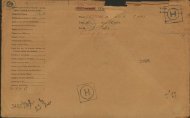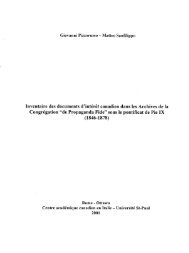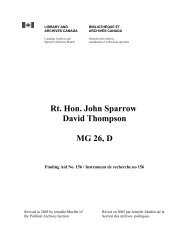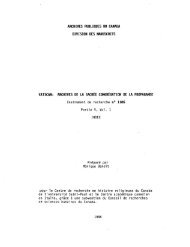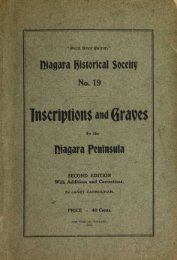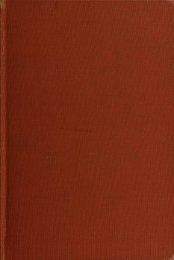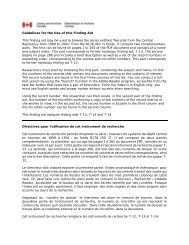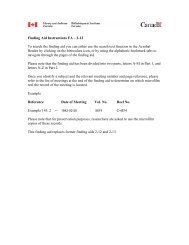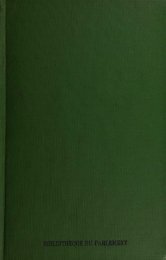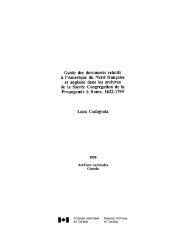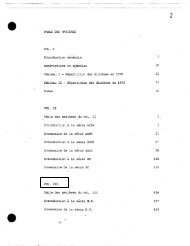Guide to Documents Relating to French and British North America in ...
Guide to Documents Relating to French and British North America in ...
Guide to Documents Relating to French and British North America in ...
Create successful ePaper yourself
Turn your PDF publications into a flip-book with our unique Google optimized e-Paper software.
<strong>in</strong> the United Prov<strong>in</strong>ces <strong>and</strong> then as the first bishop of Baltimore. In 1910 he published a series of 34<br />
documents <strong>in</strong> their orig<strong>in</strong>al language, drawn from different series (Acta, Lettere, Congressi, Instruzioni,<br />
Decreti), cover<strong>in</strong>g the years l783-1789. 11S Although partially used by Shea,lI6 these documents were<br />
almost entirely unpublished <strong>and</strong> unknown. As always, the transcription leaves much <strong>to</strong> be desired. ll1<br />
On account of their <strong>in</strong>terest, Fish's documents were almost immediately translated <strong>in</strong><strong>to</strong> English by the<br />
Jesuit Edward I. Devitt. lI8 In a brief <strong>in</strong>troduction <strong>to</strong> the documents, Devitt describes Fish's work <strong>and</strong><br />
the copies of the documents of Propag<strong>and</strong>a that Shea had left with the archives of George<strong>to</strong>wn<br />
University.lI9<br />
Guilday used the George<strong>to</strong>wn University copies some years later <strong>to</strong> write an article on the years<br />
1783-1785 <strong>and</strong> Carroll's appo<strong>in</strong>tment. 12o This was useful summary of facts already known, but no new<br />
sources were <strong>in</strong>troduced. Two years later, Guilday published a complete biography of Carroll. l2l<br />
Although he used the documents of Propag<strong>and</strong>a aga<strong>in</strong>, <strong>and</strong> this time more abundantly, Guilday had still<br />
not consulted the archives of the Congregation directly, but had some additional copies made for his<br />
own use. 122<br />
Thomas O'Brien Hanley recently edited all of Carroll's papers. 123 Although many of the published<br />
documents come from the archives of Propag<strong>and</strong>a,l24which is only one of the many archives consulted,<br />
it does not seem that a systematic search was carried out. Carroll's letters were drawn exclusively from<br />
Congressi. The SOCG series, which is equally important for its references <strong>to</strong> Carroll, was not at all<br />
mentioned, even though several documents appear<strong>in</strong>g <strong>in</strong> that series were published via copies kept <strong>in</strong><br />
other <strong>America</strong>n archives. Therefore most of Carroll's letters that are <strong>in</strong> the present Calendar or <strong>in</strong><br />
Kenneally's United States <strong>Documents</strong> are not <strong>in</strong> the Carroll papers. In addition, the edi<strong>to</strong>r has chosen<br />
merely <strong>to</strong> <strong>in</strong>dicate the names of the archives consulted at the bot<strong>to</strong>m of each document, omitt<strong>in</strong>g all<br />
data regard<strong>in</strong>g archival series or folio numbers. This makes the process of f<strong>in</strong>d<strong>in</strong>g specific <strong>in</strong>formation<br />
on any orig<strong>in</strong>al document very difficult.125<br />
In conclusion, one can say that, except for a few cases, the his<strong>to</strong>ry of the relationship between<br />
Propag<strong>and</strong>a <strong>and</strong> <strong>North</strong> <strong>America</strong> has yet <strong>to</strong> be written. The pr<strong>in</strong>cipal exception is Mor<strong>in</strong>'s work, which<br />
was unfortunately never published. Other notable exceptions are the articles written by Campeau,<br />
Lemieux <strong>and</strong> O'Neill, which stemmed from Metzler's Sacrae Congregationis de Propag<strong>and</strong>a Fide<br />
Memoria Rerum, <strong>and</strong> this writer's Coldest Harbour. Several questions therefore rema<strong>in</strong> unanswered.<br />
How did the officials of Propag<strong>and</strong>a see the New World? Did their attitudes change over time? How<br />
did these attitudes <strong>in</strong>fluence their periodical decisions vis-ti-vis <strong>North</strong> <strong>America</strong>? What <strong>in</strong>fluence <strong>and</strong><br />
what authority did they have over missionaries, vicars apos<strong>to</strong>lic <strong>and</strong> bishops operat<strong>in</strong>g <strong>in</strong> <strong>America</strong>?<br />
What place did <strong>North</strong> <strong>America</strong> have <strong>in</strong> the overall policies of Propag<strong>and</strong>a? What was the power of the<br />
Congregation <strong>in</strong> the context of the Holy See's general policies of missionary expansion? Is it possible<br />
<strong>to</strong> determ<strong>in</strong>e <strong>in</strong> what way the his<strong>to</strong>ry of <strong>French</strong> <strong>and</strong> <strong>British</strong> <strong>North</strong> <strong>America</strong> was <strong>in</strong>fluenced by the<br />
decisions made <strong>in</strong> Rome <strong>in</strong> the offices of Propag<strong>and</strong>a or of the Holy See <strong>in</strong> general? The his<strong>to</strong>rian who<br />
can provide answers <strong>to</strong> these questions will shed new light on some important po<strong>in</strong>ts regard<strong>in</strong>g the<br />
development of <strong>North</strong> <strong>America</strong>n his<strong>to</strong>ry <strong>in</strong> the colonial period.<br />
51



